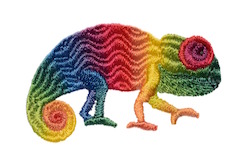Coloured embroidery threads on demand save time, money and the environment
To work with a range of colours, traditional embroidery must use multiple reels of thread, one for each colour. This impacts on efficiency with lost time due to re-threading, in turn increasing the cost of the process. It also limits the range of designs which can be adopted by industry. With the support of EU funding, the Swedish company Coloreel has developed technology which achieves high-quality textile thread colouring on demand, during production. The unit to be launched later this year will be developed with Ricoh, which will build one of its major sub-systems based on its inkjet printing technology. It is intended to be used in conjunction with existing industrial embroidery machines and will improve production efficiency and expand the range of unique designs possible. Doing more with less The production process for embroidery currently faces a number of limitations. Thread dyeing plants can only colour single-coloured threads. Therefore, to satisfy customer demand, embroiderers and factories must stockpile large quantities of many coloured thread rolls. As thread makers only provide 400-500 solid colours, customers rarely get the exact colours they seek. Additionally, the embroiderers can only create stitch segments of solid colours, with soft transitions or other effects virtually impossible using today’s technology. From the point of view of production efficiency; to meet customer expectations embroiderers must often exchange a large number of thread rolls between each order which is time consuming, increasing the setup time for each job. Actual production time is also increased as the machine has to do lock stitches, stop, cut and change thread between each colour segment, compromising quality. The EU-funded ITC (Revolutionary instant thread colouring technology for industrial embroidery) project uses one thread reel instead of several, opening up embroidery design to new colours and gradients which can now be combined in innovative ways, for example for smooth colour shifting and shading. As project coordinator Dr Mattias Nordin elaborates, “By instantly colouring a white base thread during the embroidery production, Coloreel enables freedom to create unique embroideries offering completely new combinations of colours.” By reducing the setup time and the necessity of maintaining inventories, the Coloreel unit also offers both higher quality and increased efficiency. It has been estimated that each colour will provide increased productivity of, on average, 30-40 % and above 80 % for more complicated designs. Rolling out a ‘disruptive’ technology Development of the thread colouring unit was undertaken with Ricoh’s engineers in Japan and England, in tandem with Coloreel’s engineers in Sweden. Dr Nordin attributes the success of ITC in part to the multidisciplinary nature of the team. As he explains, “Working with specialists in computer software and hardware alongside mechanics, chemistry and physics has meant the project could develop this disruptive technology from a synthesis of cutting-edge solutions across disciplines.” Another important asset of the unit is that it is more environmentally friendly than traditional techniques. As the system only produces the thread actually needed, there is very little waste generated. Additionally, there is almost zero waste water used in the Coloreel unit compared to the textile industry in general – the biggest water pollutors globally. With no comparable product on the market, the team will first target the European market working with customers in leading textile, fashion and sportswear companies, before launching the unit in the autumn. Further down the line the team anticipate the development of units applicable to the knitting, weaving and sewing markets. For more information, please see: Project website
Countries
Sweden



